Pasta e Ceci
Pasta e Ceci – Garbanzo Beans with Pasta
Two and a half years ago when I started writing I compiled a list of ideas, recipes and foods I wanted to write about. On that list was the chickpea. I even called it the lonely chickpea. Well, it just goes to show you that if you wait long enough everything comes into fashion in the U.S. They are a staple of Italian cuisine where they are left whole or pureed, and used in salads, soups, antipasti, fritters, farinata, main dishes and desserts. We rarely saw them here, especially on the west coast, but now every month I see more and more recipes in magazines, books and blogs, television shows and restaurants. From lonely to ubiquitous, this legume has come a long way.
Cicer arietinum, also known as garbanzo beans or ceci are an ancient food. Their presence has been documented in very ancient Jericho, Neolithic Turkey, and Bronze Age Greece and Rome. Roman tavern keepers and street vendors made cakes of them that were enjoyed by citizen and slave alike. In Roman homes chickpeas were served in the simplest fashion – just boiled and seasoned. From Apicius, ancient Rome’s most famous culinary writer, comes a simple preparation of cooked ceci and green beans tossed with olive oil, cumin, red wine, salt and pepper. They also formed the base for soups and side dishes. Also from Apicius comes a recipe for chickpeas roasted in olive oil and served with white wine, anchovy paste and pepper. These were eaten out of hand, like roasted nuts. Lest you think the recipes of ancient Rome’s culinary master are a thing of the past, take a look at this offering from the March 2013 Bon Appetit magazine. Popping up every where.
The beans themselves are actually pulses, the seeds of a legume. You can purchase them either dried or canned. I prefer dried ceci. When cooked, dried ceci take on a lovely golden hue and hold their shape beautifully. They have a clean pure taste with none of the off or metallic notes or mealy texture occasionally encountered in their canned counterpart. If using canned ceci, rinse them in a colander prior to adding them to the dish. Use either variety well within one year of purchase.
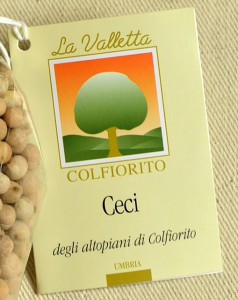 The beans can vary in quality and range in price from less than a dollar up to about $6.50 per pound. My favorite? Umbria’s La Valletta brand. Brother and sister team of Alessandro and Rosalba Cappelletti devote their energies to the sustainable production of grains and native legumes, and their products are of the highest quality. They are available from Gustiamo.com and other fine purveyors.
The beans can vary in quality and range in price from less than a dollar up to about $6.50 per pound. My favorite? Umbria’s La Valletta brand. Brother and sister team of Alessandro and Rosalba Cappelletti devote their energies to the sustainable production of grains and native legumes, and their products are of the highest quality. They are available from Gustiamo.com and other fine purveyors.
Dried ceci must be soaked prior to cooking. For best results I recommend soaking for 20 to 24 hours during which time they will double in size and take on their characteristic yellow color.
They must be boiled for about 1 ½ hours, perhaps longer depending on their age. For soup and some stews the cooking may be done in two stages, first in clear water and then finished along with the main ingredients for the dish itself. A note on salting – do not add salt to the soaking water. Wait until the ceci are almost cooked before you add salt. Salt will toughen the skin, and interfere with the cooking process.
Everyone knows Pasta e fagioli, or as we called it in my home when I was growing up, Pasta fazool. It seems every family has its own version. Less well known in the U.S., but just as good, and with as many variations, is Pasta e ceci. Start with a base of aromatics, add vegetable or chicken broth, ceci, pasta and spices for simple, soul satisfying fare.
Pasta e ceci
serves 4 to 6
12 ounces dried chickpeas
1 stalk of celery with leaves, cut in 1/4 inch dice
1 carrot (optional), cut in 1/4 inch dice
1 small onion, minced
2 cloves of garlic, minced
1 6 inch sprig of rosemary
3-4 cups brodo di pollo
1/3 cup olive oil
1/4 teaspoon peperoncino
2 tablespoons chopped Italian parsley
salt and freshly ground black pepper
1/2 to 3/4 cup small pasta such as pennette, small elbows, or broken larger pasta
Rinse ceci and place in large bowl. Cover with 3 inches of cool water. Soak 24 hours, changing water once. Do not add salt.
Drain ceci and pour into 4 quart pot. Cover with 2 inches cool water. Bring to a boil. Decrease heat to simmer. Cook 45 to 60 minutes until beans begin to soften, skimming and discarding foam. Cooking time will depend on the age of the beans. Drain in colander, and set aside.
Pour olive oil into a low four quart pot. Add diced celery and leaves, carrot (if using), minced onion, garlic and rosemary. Toss to coat with oil. Cover pot and sweat vegetables over low heat until softened, being careful not to let them color, about 12 minutes.
Add 3 cups brodo and drained ceci to pot. Bring to a boil. Decrease to a very mild simmer and cook, partially covered, about 40 minutes or until beans are tender. Remove 1/2 cup of beans and puree with immersion blender or in food processor. Return to pot, add pasta, peperoncino, 1 teaspoon kosher salt and a few twists of black pepper. Cook 10 minutes more or until pasta and beans are done. Add remaining broth, if desired. Remove and discard rosemary stem. Add chopped parsley. Check for seasoning. Serve.
Use your favorite brodo di pollo (chicken broth) or click here for my recipe.
Hungry for more ceci? Check out the Tubettoni Pasta with Chickpeas at Italian Food Forever.
Note: You can click on any picture for a slide show!
I have no affiliation with any product, manufacturer, or site mentioned in this article.
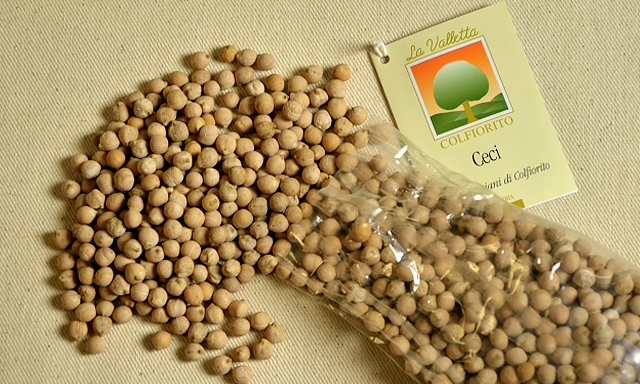
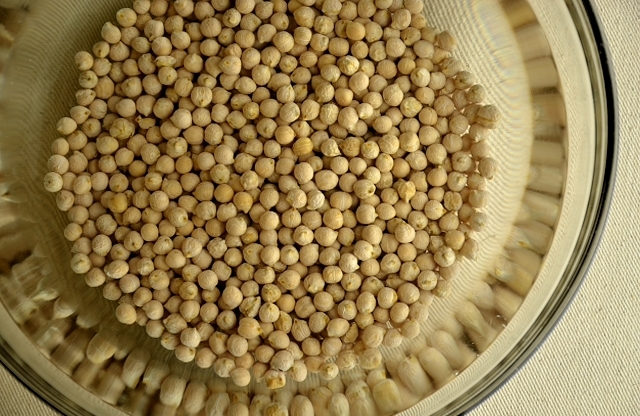
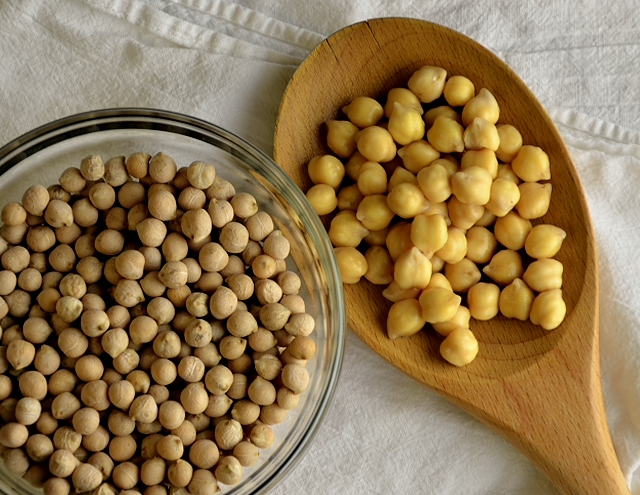
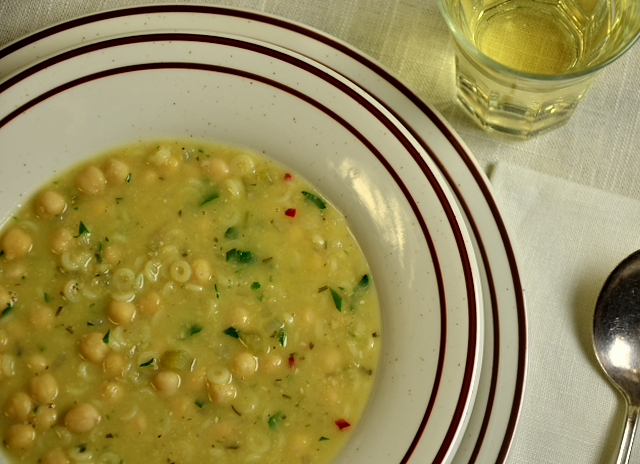

Wednesday, February 27th 2013 at 11:36 pm |
Tradizione e gusto qui non mancano mai! <3 Complimenti cara.. è deliziosa e ben fatta, un capolavoro!! Un abbraccione!
Thursday, February 28th 2013 at 7:29 am |
Grazie, Ely!
Come sempre, sei troppo gentle. Buona giornata!
Thursday, February 28th 2013 at 1:57 am |
I love pasta e ceci! Bravissima Adri:***
Thursday, February 28th 2013 at 7:30 am |
Ciao Simona,
I love it too. It is simple to make, and really satisfying. Un bacione!
Thursday, February 28th 2013 at 5:49 am |
Ain’t that the truth about waiting long enough and things come into fashion? Chickpeas are the rage everywhere it seems, and I love a good chickpea soup too. Yours is a wonderfully enticing version. At first when I saw them spilling out of the package in Bart’s photo, I thought he was trying to emulate the shape of the Italian peninsula.
Thursday, February 28th 2013 at 7:36 am |
Ciao Linda,
Indeed, as the song says “Everything old is new again.” I await my turn. For years Americans disdained the garbanzo bean, but a legume awakening is on the horizon, uno proprio rinascimento! Chickpeas sure are having their moment. And you are right about Bart and his ceci art!
Thursday, February 28th 2013 at 2:56 pm |
My mom’s pasta fazool was made with cannellini beans – from a can of Progresso. But as a grown up person, chickpeas are a big part of my life – thank goodness! I crave them, and throw some in my lunch salad every day along with whatever leftover roasted vegetables I have…plus lemon juice, olive oil, cheese…
For a while, it was work to find dried chickpeas that weren’t a hundred years old. They would take hours to cook, so I got into the habit and convenience of canned. But a few of my local stores seem to have better turnover. I’m back to cooking my own. If they’re really fresh, it takes less than an hour to cook a batch for the week, after soaking.
I like that you puree some of the chickpeas to give the soup velvety body – yum.
Thursday, February 28th 2013 at 3:15 pm |
Benvenuta!
My biggest childhood memory of chickpeas was in Italian restaurants – mostly a pizzeria where they adorned a salad, and where I always picked them off! Thank heavens I know better now. Thank heavens also, the chickpeas are better now. You are spot on about freshness being key. Some of that I have purchased were so old, those babies would never cook through. See if you can find out La Valletta brand. They are well worth the price. And thanks for stopping by. Welcome to the Chickpea Sisterhood!
Thursday, February 28th 2013 at 4:09 pm |
Pasta e ceci was my mom’s go-to dish when I was growing up….on a particularly busy night, she’s make a quick tomato broth with some homemade tomato sauce and water and cook tubettini and ceci right in there. A dollop of good olive oil and dinner was ready. If she didn’t use the whole can of ceci, the rest was dressed with oil, Sicilian oregano and a pinch of salt.
Thursday, February 28th 2013 at 5:10 pm |
Hi Michelle,
Your mom had it down! One of the most rewarding things about food writing is hearing other people’s family stories. Thanks for sharing!
Thursday, February 28th 2013 at 6:11 pm |
Adri, I never realized you soak them for 20-24 hours, I have to admit I never prepared the dry, now I want to try and make your gorgeous soup. One of my favorite snacks are roasted and salted ceci and fava beans, they’re addicting!
Thursday, February 28th 2013 at 9:23 pm |
Hi Marie,
Indeed, I’ve found that a good long soak makes all the difference in the world. I love roasted ceci too. They are wonderful – the same way the ancient Romans enjoyed them! Salve!
Friday, March 1st 2013 at 4:42 am |
Adoro i ceci, sani e nutrienti, gustosa zuppa!!!!!
Friday, March 1st 2013 at 6:34 am |
Anch’io! I ceci sono buonissimi!
Friday, March 1st 2013 at 11:31 pm |
Dear Adri, pasta and ceci was my favourite soup when I was a child (pasta and fagioli was too salty for my young palate), but as an adult I…stopped to eat it (shame!). Now that I saw your recipe I feel keen to try it again, my ‘Roman version’ is with tomatoes but maybe I should try your white version and see if I like it better. Colfiorito brings back so many nice memories to me. I know this little village and it is very famous for quality potato production, I did not know that it also was popular for legumes production…
Saturday, March 2nd 2013 at 8:14 am |
Hi Rita,
I have heard from so many people who love this soup! The brother and sister who own La Valletta in Colfiorito are very serious about organic and sustainable agriculture, and they produce many fine products. Thank you for the info on their potato production.
Sunday, March 3rd 2013 at 1:19 pm |
Pasta e ceci is a delicious alternative to pasta e fagioli in our household, too. As other readers have also commented, our version includes passato di pomodoro and pasta al uovo. Black pepper, a drizzle of olive oil on top and some toasted crusty bread to dip perfects this soup!
Sunday, March 3rd 2013 at 8:54 pm |
Hello you two!
As with its more famous cousin, Pasta e fagioli, it seems every family has its own version – even within families I have seen variations. This flexibility and adaptive innovation of Italian cuisine both amazes and delights me. Thank you for sharing yours. Stay warm in Minneapolis. Eat Pasta e ceci!
Monday, March 4th 2013 at 12:40 pm |
salutare e nutriente, una zuppa perfetta!!!!!
Monday, March 4th 2013 at 12:42 pm |
nutriente, genuina, perfetta!!!!!
Monday, March 4th 2013 at 9:07 pm |
Grazie, Simona per le tue gentilissime parole!
Wednesday, March 6th 2013 at 6:05 am |
Quanto mi piace la pasta e ceci, perfetta in queste giornate ancora fredde!!!
Un bacio grande!!!
Wednesday, March 6th 2013 at 7:51 am |
Ciao Lory,
Questo post e molto populare. Si, pasta e ceci e ora perfetta, davvero!
Monday, March 11th 2013 at 6:14 am |
If you ask me, ceci are the very tastiest of legumes. And dirt cheap, too—but I’m afraid that their new-found popularity will change that…. Still, nice to know that people are catching on to their charms.
Monday, March 11th 2013 at 7:54 am |
Hi Frank,
I love them. My husband does not share my enthusiasm. I fear he is locked into memories of picking “garbanzo beans” off his “mixed green salad” as a kid. Aside from having real flavor, they have numerous health benefits. And you are right about the cost. One can certainly go high, price wise, as with La Valletta brand, but for every day consumption, and especially for those on a budget, they are a smart and astoundingly versatile choice.
Tuesday, March 12th 2013 at 8:21 am |
I absolutely love chickpeas, especially when they’re combined with any sort of pasta, which i’ve really only seen in italian cooking. One of the many reasons I love italian food! your pasta e ceci looks just wonderful – YUM!
Tuesday, March 12th 2013 at 8:34 am |
It’s perfect for winter, and thanks for stopping by!